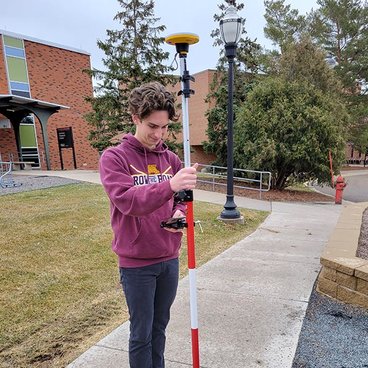
The Department of Forest Resources is committed to providing our students with a well-rounded education to prepare them for a career in the natural resources. That means training them to use cutting-edge technology while keeping the costs of that technology as low as possible. Last fall, the department raised over $4,500 to provide new field equipment to our students to use today in their classes and going forward through their careers.
Andy Jenks, a Teaching Specialist in the Department of Forest Resources, guided some of those funds to purchase a new global positioning satellite (GPS) system that integrates seamlessly with the smartphones most people, including our students, use every day. Students and natural resource professionals can use the system to collect an accurate GPS location on their position within centimeters, an improvement over the six foot radius provided by traditional GPS systems.
Andy says, “This system can fill any geospatial location need we might have. Students can use it to plot streets or roads, boundaries on wetlands, locations to plant a tree, trees to cut down, or anything else, really.”
This new system is the current industry standard in forestry, and we are providing our students the training and experience they’ll be able to use on their first day of their careers. The system is cloud-based and operates on a software-as-service subscription model, which means there is no hardware to store, maintain, update, and replace. “Distribution is easy,” Jenks says, “It works right on their phone, which they are already accustomed to using. They can download it right from their app store and can open it anytime.”
Jenks also sees the potential for other projects, departments, and colleges within the university to benefit from our investment. Researchers needing precise GPS location data could use the system for their projects, allowing the system to fill a wider university need while many students are away from the summer.
Teaching students to use a new technology can be difficult. Instructors generally want to coach students to learn and figure things out for themselves, not just tell them which buttons to push, because eventually those buttons are going to change—and probably sooner than we think. It’s valuable for students to understand the fundamentals of the systems behind the tools they use; however, that needs to be balanced with practical skill in using them.
“We used to invest a lot of our time, as a society, teaching people how to ride a horse, feed it, brush its hair, maintain its shoes, and so on; and then one day the automobile comes along and all of that foundational knowledge is no longer relevant to the task at hand. Students don’t necessarily need to know all of the intricate details of how their smartphone works; they just need to know how to work it.”
The Forest Scene newsletter is published biannually in the spring and fall, featuring stories and updates from the Department of Forest Resources. Readers can download issue 27 of Forest Scene as an interactive PDF that is fully tagged and compatible with most screen readers, or read the individual stories here in a web-based format.
- Letter from Dr. Mike Kilgore
- Alumni Spotlight: Greg and Jan Bernu
- Student Spotlight: Catherine Glenn-Stone
- Research Spotlight: Dr. Kristen C. Nelson
- Research Spotlight: Dr. Chris Edgar
- Community of Support: Andy Jenks and Cole Kiernan

